
by Joshua Criss | Apr 21, 2025
Lawns are as American as apple pie, and Granny’s cookies. It’s where you play ball with your kids, and have summer cookouts. It’s also quite likely a huge source of frustration. How much water, how much fertilizer, how much work, and why bother? All of these are valid questions, and ones this article seeks to clarify. We’ll delve into the benefits of healthy lawns, and cover some easy cultural practices you can implement right now for a green and lush lawn all summer long.
The Benefits of Lawns
Turfgrass provides a number of ecological services. These are defined by the USDA as “direct and indirect benefits provided to humans by an ecosystem to include provisioning, regulating, supporting and cultural services”. This term has multiple categories, which are outlined below.
Provisioning (AKA Material and Energy Output)
Provisioning or material/energy output is linked to a grass’ bio-filtering capability. Grasses remove pollutants from applied water including stormwater, while enabling ground infiltration. This recharges surface reservoirs, and by removing pollutants, mitigates eutrophication while providing clean drinking water to communities.
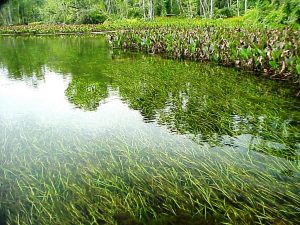
UF/IFAS Photo: Jess Van Dyke
Regulating (AKA Moderation and Control of Ecosystem Processes)
Grasses are known to cool the surrounding environment, capture dust, and prevent erosion.
Water absorbs heat as it vaporizes as it does in the evapotranspiration processes in plants. As Ben Franklin taught us many years ago, that process cools the environment around through heat absorption as water vaporizes. This cooling effect can be quite significant, and translates to saving through reduced air conditioning of your home.
Grasses remove dust and pollen particles from the air as well. This is usually a process by which wind blows the dust onto the grass, the dust settles and is captured beneath the grass canopy.
To complete the trifecta, grass has a thick root mass locking soil in place. The two main methods for soil erosion are through wind, and water flow. The grass’ root system negates both of these.
Supporting Services (AKA Maintaining Fundamental Ecosystem Processes)
Supporting services, as this sections title suggests, are those which support life processes. In the case of grasses, this comes in the form of organic matter. As I hear often, soils in Florida are quite sandy and lacking in the aforementioned organic matter.
It may surprise you to hear that grass is probably the easiest method to make these additions. As we leave clippings on the lawn and root systems slough off only to regrow the following spring we actually are adding organic matter from two directions. Hence grass’ reputation as a great soil builder.
This organic matter is where our supporting services really shine. Your turfgrass acts as habitat for microbiota, and macrobiota. These terms refer to the bacteria, fungi, algae, earthworms, and other insects which help cycle soil nutrients while breaking down the same organic matter you’ve added simply by not removing your grass clippings.
Cultural Services (AKA Societal Benefits)
These are somewhat self explanatory. It is in this realm where we begin to discuss those neighborhood block parties. Lawns are an excellent place to meet with neighbors and build communities. Well maintained lawns can also affect home prices, improve neighborhood aesthetics, and even effect crime rates in a given area.
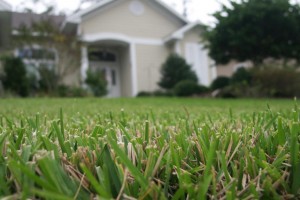
UF/IFAS Photo
It Starts with Cultural Practices
Hopefully by now, you are sold on keeping a healthy stress free lawn. The real question is how to achieve one? You’ve likely heard that lawns are difficult to maintain, but you’ll be happy to know it’s much easier than advertised. You’ll see rapid results if you start paying attention to three practices.
Irrigation
Easily the biggest killer of grasses in North Florida is irrigation. Often too much is applied, and is at the wrong time of day. All turfgrass species in Florida require only ½ -3/4 inch of water per irrigation event. Water your grass before dawn when you notice bent grass blades, slight color changes, and a lack of rebound when stepped upon.
Not sure how much you’re applying? Place some containers in your watering zone spread evenly and run the system for 15 minutes. Measure that outcome with a ruler, adjust your timing as necessary to hit the right amount.
Fertilization
Fertilization is based on turfgrass species. Overdoing things can be quite harmful to your lawn, so make sure you check the Florida Lawn Handbook for the specifics on your grass species.
Before you get started fertilizing, there are a few bits of information of which you should be aware. The first is your soil’s pH, as it dictates nutrient availability for your grass. The second factor in fertilization is timing. Apply fertilizer in multiple applications beginning April 15th and ending in September. This ensures your grass will have enough root mass to utilize the nutrients.
Mowing
Our final cultural practice is mowing. It is critical to mow plant to the appropriate height. Mowing to proper height keeps grass stress free reducing susceptibility to insects, disease, drought or sunscald. Here again, height is dependent on grass species. Consult the Florida Lawn Handbook for greater detail.
Whatever the height required. Make sure to mow grass with sharp blades, only when dry, and weekly to avoid damage to your plants.
To Sum it All Up
Turfgrasses are an integral part of any landscape when sited correctly. They provide a wealth of functions both ecological and cultural. Take a little time to integrate the practices outlined above and you’ll discover an easy to maintain groundcover primed for your next family cookout. As always, if you have any questions or need any help on this topic and more, contact your local Extension Office.
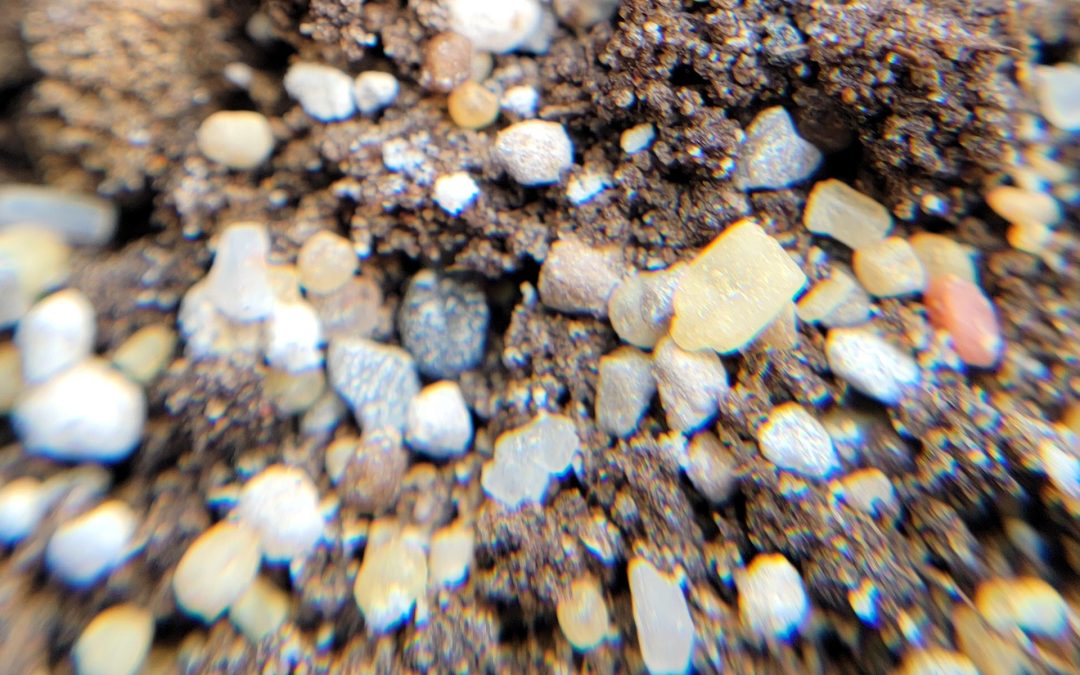
by Joshua Criss | Mar 6, 2025
Ah, springtime is approaching quickly. You and I both know you’re getting anxious to get out into your gardens to grow your plants. I’m not faulting you, far from it. You’ll find that your local Extension agents want your garden to succeed as much as you do. Because we all want you to have a bountiful harvest, we need to have a conversation about fertility in your lawns and gardens.
Definitions
Before we get too deep into this topic, let’s define nutrition. You may hear some refer to fertilizers as “plant food.” While this is a common phrase concerning fertilizers, it is not factually accurate. Food is associated with energy creation within an organism. Plants are autotrophs, meaning they convert sunlight into energy. So, under this premise, sunlight is plant food, whereas plant nutrition is the building blocks of tissues or catalysts of metabolic processes.
The 17 elements designated as plant essential nutrients are categorized based on the quantity needed for healthy growth. All are important to have in your soil; as per the “Law of the Minimum,” your plant’s development will be limited based on the most deficient element.
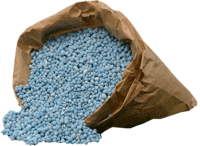
UF/IFAS Photo
Macros
Those elements with the largest demand within the plant are known as macronutrients. The three most critical of these are very often absent in fertilizer conversations as they cannot be added to soil in granule form. These are carbon, hydrogen, and oxygen, and their presence in your garden results from your cultural practices. You get them from air and water in the pore spaces of your soil. Appropriate tillage and irrigation are the only ways to provide these elements to your plants. They are critical for proper photosynthesis and fluid balance in the plant.
The most discussed elements are so vital that they make up the three numbers on every bag of fertilizer. These are nitrogen (N), phosphorous (P), and potassium (K), all of which may be added to soil to overcome deficiencies (N often being the limiting factor). These elements are crucial for protein creation, photosynthesis, and fluid movement.
Secondary Nutrition
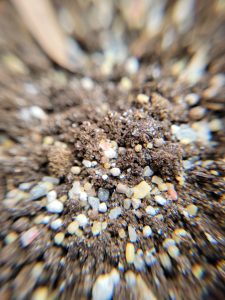
UF/IFAS Photo: J. Criss
The next set of nutrients have less demand than NPK. They are sulfur (S), magnesium (Mg), and calcium (Ca). Ca is essential for cell structure but is often abundant in our soils. S is frequently rained out of the atmosphere (though you may still need to add some) and facilitates enzymatic processes in plant cells. Mg needs the most attention in this category as it has a lot of mythology among gardeners. You’ve likely heard you should add this element to “green up” your plants. While it is true that Mg is critical to chlorophyll, adding it without testing for deficiencies first is a recipe for poor plant growth.
Micros
Our final category of fertilizer is micronutrients. These are iron (Fe), manganese (Mn), boron (B), chlorine (Cl), zinc (Z), copper (Cu), molybdenum (Mo), and nickel (Ni). These serve various functions in the plant, mainly in metabolic processes.
To Sum Up
Plant fertilization is critical for lawns and gardens. It behooves gardeners to understand these elements and their role in plant growth. Once you do, you’ll understand the importance of applying the correct version of the element in the proper amount at a time and location to maximize use efficiency. You can learn more about what they do and how they react in the soil here. For more information, contact your local extension office.

by Mark Tancig | Feb 27, 2025
It’s almost March and it’s not just March Madness that’s about to happen, but No Mow March. This year will be the third year that the Horticulture Extension Agents of the UF/IFAS Northwest District have promoted No Mow March. The No Mow March campaign encourages those with lawns to leave some late winter/early spring wildflowers to benefit wildlife.
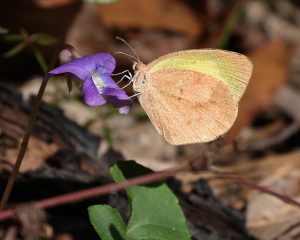
A Barred Yellow butterfly visit a violet, one of our late winter wildflowers that can be found in your lawn. Credit: Steve Coleman.
If you don’t think you’re ready to skip mowing the whole lawn for the whole month of March, then maybe you could try a small piece and hold off as long as you can. The point is to get you thinking of how your lawn, usually not considered an inviting place for most wildlife, can actually provide valuable ecosystem services. Many pollinator species in our area are emerging from their winter break and looking for food as we move into March. Plants in your lawn that are typically considered “weeds” are perfect pollinator feeders at a time when other landscape plants have yet to begin flowering. Providing extra floral resources can be especially useful in more developed areas where well-kept landscapes reduce what’s available for pollinators. Since the health and abundance of insect pollinators contribute to the ability of higher organisms, especially birds, if there’s more insects, then there’s more food for the birds, too!
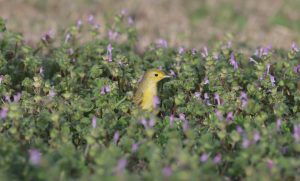
While you’re not mowing, try observing the wild plants and animals that visit your lawn. You can get help identifying them by using apps like iNaturalist or Seek. You could also spend some time ripping out part of the lawn and planting a new flower bed of native plants. Or you can focus on identifying any invasive plant species in your landscape and work on removing them.
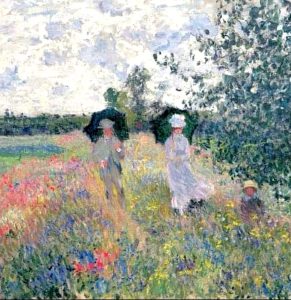
Instead of mowing, take a walk in the wildflowers during March. Credit: Taking a Walk near Argenteuil by Claude Monet.
The Horticulture Extension Agents of the UF/IFAS Extension Northwest District have put together a No Mow March website with more information, including a list of related workshops and classes, as well as a pledge you can take to affirm your choice to participate.
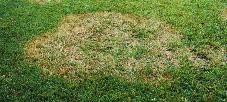
by Sheila Dunning | Feb 19, 2025
As the temperatures warm into the 60’s (or greater) and the rain chance remains good, keep an eye open for disease in your lawn. Large patch disease is common in turfgrass this time of the year. It is caused by the fungus Rhizoctonia solani. The fungus is present in the soil and thatch layer year-round. When the temperatures rise into the 60’s and 70’s it begins to spread. Large patch thrives under these conditions, especially when the soil is wet. With frequent showers the disease spreads quickly. The first symptom of large patch is circular, discolored areas within the lawn. The outer borders of the patches are orange to yellowish in color. In the center of the circle there are grass blades trying to green up again. They are usually unsuccessful, resulting in odd-shaped patches of dying grass that begin to connect to each other.

Picture from UF publication
A simple field diagnostic techniques to confirm large patch disease is to pull on the diseased grass shoots near the edge of the circle. The blades will come loose from the stolon easily. At the base of the leaves the stem and sheaths will appear dark brown and rotten. Yes, it is large patch.
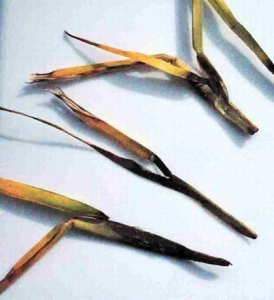
Photo from UF publication
If the weather gets colder or hotter very quickly, the disease will go back into dormancy. Looking at the long-range temperature predictions, the rest of February will be going up and down. Remember, the groundhog said six more weeks of winter. So, start looking for a fungicide or two or contact your pest control service. However, remember fungicides don’t cure existing problems. They are utilized as a protectant for the unaffected portions of the grass. When favorable conditions are present, the turf should be sprayed in order to keep the fungus from penetrating the grass blades. Repeat applications will be needed for as long as the weather is cool and wet. Check the product label for the correct intervals. Several cultural practices promote large patch infection including over-fertilization, over-irrigation, low mowing height, poor drainage and excess thatch. This spring, after the grass has greened-up on its own, is a good time to look at these factors and make corrections. Keep a close eye because as soon as the temperatures drop again in the fall, large patch can reappear if the corrections were not complete. For more information: https://edis.ifas.ufl.edu/lh044
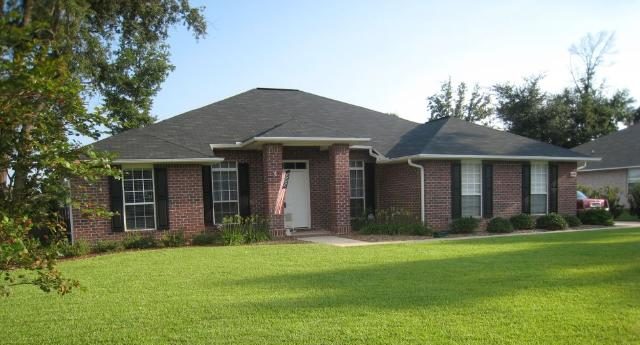
by Joshua Criss | Jan 9, 2025
Well folks, the earth has made yet another trip around the sun, and we find ourselves in another of hopefully many a new year. The weather has been cold, but it’s important that we spend a few moments plotting a strategy for our lawns in the coming year. Lawncare is a subject which is shrouded in myths and often misunderstood. Luckily, a little bit of knowledge can help you achieve stress free healthy turfgrasses.
Lifecycle
The first thing homeowners should understand is how turfgrass grows throughout the year. Turfgrass is split into warm and cool season species. You may have guessed that in the Florida Panhandle, warm season grasses are dominant. These grasses perform well in warmer weather going dormant when temperature begins to fall. During this dormant period, these grasses turn brown and may appear to have died. The grass itself is alive and well, but the roots have died back significantly.
Fertilizers
Why is this an important piece of information? There is no point in applying fertilizers to turfgrasses with no ability to absorb them. Instead, waiting until mid-April (think Tax Day) for fertilizers provides two key benefits. First, it allows time for the grass to develop a thick mat of roots. As roots are the main tissue for nutrient entry into plants allowing your lawn to utilize the applied nutrition. Second, waiting until a little later evades late season freezes. Cold weather may harm early season growth which stresses your lawn which could cause die back allowing weeds to take over.

UF/IFAS photo: GI-BMP
Weed Prevention
The subject of weeds brings us to a critical cultural practice in terms of lawncare. The application of preemergent herbicides. These herbicides are designed to create a barrier in the top 1/2 inch of soil which prevents shoot and root growth after weed seed germination.
Now, it’s important to understand, there are hundreds of thousands of weed seeds in the top layers of soil all over the world. Weeds take advantage of open spots in your lawn as does any plant in any ecological system.
A preemergent herbicide prevents weed from being able to fill those spaces, by preventing their growth. Given the proper watering and fertilization, your grass may now fill these voids. Your lawn will outcompete the weeds and become its own preventative.
Selecting and application of a pre-emergent herbicide does have some nuance. Not every product is compatible with every grass type, consult our Weed Management Guide to select a product that will work for your lawn. Another concern is application timing and frequency. Multiple applications will likely be required in the spring due to those triggers which break seed dormancy combined with product efficacy timelines. Local extension offices are a great resource for specificity, but generally application will need to be mid-February with a second application 6-8 weeks later based on the product label. Also important to note is that this is a long-term process. It may take a few years of spring and fall application to eradicate the weeds in your lawn.

Lawn decline from weed infestation UF/IFAS Photo: Pawel Petelewicz
To Sum Up
Turfgrasses make excellent groundcovers and are look best when grown as stress free as possible. In the early parts of the year that entails holding off on fertilization and adding a layer of protection for summer weeds. Getting to know your turfgrass and familiarizing yourself with proper cultural practices will go a long way to making a healthy lush lawn. For more information you may read through our Florida Lawn Handbook or consult your local Extension Agent.
















